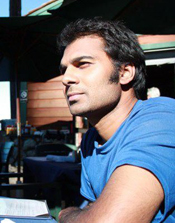Thirty-seven-year-old neurosurgeon Paul Kalanithi died on March 9 of lung cancer. In the approximately two years since his diagnosis, he continued to practice, to teach at Stanford and to write about how his lives as doctor and as patient intersected (Kalanithi had bachelor’s and master’s degrees in English literature and earlier in his life planned to be a writer).
In his essays, “How Long Have I Got Left?” for The New York Times Sunday Review (January 2014) and “Before I Go,” for Stanford Medicine Magazine, reprinted on March 12 in The Washington Post, Kalanithi pondered the nature of time.
In the NYT:
The path forward would seem obvious, if only I knew how many months or years I had left. Tell me three months, I’d just spend time with family. Tell me one year, I’d have a plan (write that book). Give me 10 years, I’d get back to treating diseases. The pedestrian truth that you live one day at a time didn’t help: What was I supposed to do with that day? My oncologist would say only: “I can’t tell you a time. You’ve got to find what matters most to you.”
Kalanithi responded to treatment and returned to work in late 2013, finishing his medical residency. He and his wife Lucy Goddard Kalanithi (a clinical instructor in medicine, also at Stanford) decided to have a child, and their daughter Cady was born in July 2014. He relapsed in spring 2014, but continued to work and write. His experience as a patient informed his teaching as well as his writing, according to his obituary released by Stanford Medicine News:
In what proved to be his last days of life, Kalanithi worked on a teaching module with the director of Stanford’s palliative care education and training program, VJ Periyakoil, MD. “The module would teach the lessons he learned from being on both sides of the aisle — being a neurosurgeon at the top of his game to being a patient with cancer. We talked about how being the doctor is all about having control and wielding power, while being a patient is all about loss of control and feeling vulnerable,” said Periyakoil, a clinical associate professor of medicine.
“His ‘dual citizenship’ as a doctor and as a seriously ill patient had taught him that respectful communication is the bedrock of all medicine. We talked about the design of the module and how we could tailor it to make our medical students understand that the so-called soft skills of medicine are the truly hard skills to teach and to learn.”
In his Stanford Medicine Magazine/Washington Post essay, Kalanithi compares how time moves for surgeons and for patients, using the fable of the tortoise and the hare:
Time for me is double-edged: Every day brings me further from the low of my last cancer relapse, but every day also brings me closer to the next cancer recurrence — and eventually, death. Perhaps later than I think, but certainly sooner than I desire. There are, I imagine, two responses to that realization. The most obvious might be an impulse to frantic activity: to “live life to its fullest,” to travel, to dine, to achieve a host of neglected ambitions. Part of the cruelty of cancer, though, is not only that it limits your time, it also limits your energy, vastly reducing the amount you can squeeze into a day. It is a tired hare who now races. But even if I had the energy, I prefer a more tortoiselike approach. I plod, I ponder, some days I simply persist.
He ends with a message to his daughter.
When you come to one of the many moments in life when you must give an account of yourself, provide a ledger of what you have been, and done, and meant to the world, do not, I pray, discount that you filled a dying man’s days with a sated joy, a joy unknown to me in all my prior years, a joy that does not hunger for more and more, but rests, satisfied. In this time, right now, that is an enormous thing.
Posted by Cara Ellen Modisett

